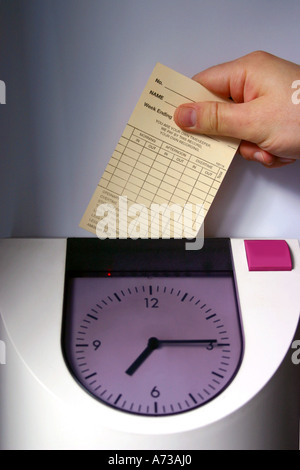Tick-Tock Tech: Revolutionizing Time Tracking with Smart Clocking In Machines
In today’s fast-paced work environment, effective time management has never been more critical. Companies are constantly seeking innovative solutions to enhance productivity and streamline operations. One such advancement that is gaining traction is the use of clocking in machines. These smart devices have transformed the traditional method of tracking employee hours, offering increased accuracy and efficiency.
Gone are the days of manual time sheets and punch cards, which were often prone to errors and could lead to disputes. Clocking in machines leverage modern technology to automate the time-tracking process, ensuring that employees accurately record their working hours with minimal hassle. As organizations embrace these tools, they are discovering multiple benefits that extend beyond simple time logging, paving the way for a more organized and transparent workplace.
The Evolution of Time Tracking
The concept of tracking time has come a long way from rudimentary methods used in ancient civilizations. Initially, time was gauged using the sun’s position and water clocks, allowing people to measure hours with relative accuracy. As societies evolved, so did the need for more precise time management, particularly in the workforce. The introduction of mechanical clocks in the Middle Ages marked a significant shift, enabling businesses to register working hours more systematically.
With the advent of the Industrial Revolution, the demand for efficient time tracking grew immensely. Factories and workplaces began adopting punch cards to record employee work hours, providing a straightforward yet effective means of tracking attendance. This system improved payroll accuracy and helped employers monitor labor hours, encouraging productivity and compliance among workers. However, punch cards had their limitations, particularly when it came to human error and the potential for manipulation.
The late 20th century saw the emergence of digital technologies that transformed time tracking further. Electronic time clocks began to replace mechanical punch systems, introducing features such as real-time data collection and reporting capabilities. This shift allowed businesses to streamline their operations and enhance accuracy. Today, with the rise of smart clocking in machines, organizations can leverage advanced technologies like biometric scanning and cloud-based solutions, marking a revolutionary leap in how time tracking is managed in modern workplaces.

How Smart Clocking In Machines Work
Smart clocking in machines utilize advanced technology to streamline the process of employee attendance tracking. At their core, these machines often integrate biometric systems such as fingerprint or facial recognition, ensuring that the person clocking in or out is indeed the employee. This reduces the risk of buddy punching, where one employee clocks in for another, improving the integrity of attendance data.
In addition to biometric features, many smart clocking in machines connect to cloud-based platforms. This allows real-time data synchronization, ensuring that attendance records are immediately updated and accessible to human resources and payroll departments. The machines can also feature user-friendly interfaces that include touch screens, making it easy for employees to check their hours and attendance status.
Moreover, these machines often incorporate mobile technology, enabling employees to clock in and out from their smartphones. This flexibility is particularly beneficial for remote or field workers who may not always be near a physical clocking in station. Overall, smart clocking in machines revolutionize time tracking with their combination of biometric security, real-time data integration, and mobile accessibility.
Benefits of Using Smart Clocking In Machines
Smart clocking in machines offer increased accuracy in tracking employee attendance, which helps reduce errors associated with manual entries. Traditional methods often lead to discrepancies due to forgotten sign-ins or human mistakes. By automating the process, these machines ensure that every clock-in and clock-out is logged precisely, allowing for reliable records that can be referenced for payroll and compliance purposes.
Clocking In System
Another significant advantage is the enhancement of operational efficiency. Smart clocking in machines streamline the time tracking process, enabling employees to clock in and out quickly with minimal fuss. This not only saves time during rush hours but also allows managers to focus on more critical tasks instead of dealing with administrative overhead. The efficiency gained can contribute to overall productivity within the organization.
Moreover, implementing smart clocking in machines fosters increased employee accountability. When employees know that their work hours are being accurately monitored, they are more likely to adhere to their schedules. This sense of ownership can boost morale and encourage a culture of responsibility, ultimately benefiting the company’s work environment. The transparency offered by these machines also builds trust between employers and employees.
Challenges and Considerations
Implementing clocking in machines presents several challenges that organizations must navigate. One primary concern is ensuring the machines are user-friendly for all employees. If the technology is too complex or not intuitive, it can lead to resistance from staff, resulting in inconsistencies in time tracking. Companies must invest time and resources into training employees and providing ongoing support to effectively integrate these systems into the workplace.
Another significant consideration is data security. Clocking in machines often collect sensitive information about employees, including their work hours and locations. Organizations need to ensure that they have robust cybersecurity measures in place to protect this data from breaches and unauthorized access. Failure to do so can lead to legal implications and damage to an organization’s reputation, making it essential to prioritize data protection during implementation.
Lastly, the financial implications of adopting clocking in machines cannot be overlooked. While these devices can improve efficiency and accuracy in time tracking, the initial investment and ongoing maintenance costs can be considerable. Organizations must weigh the long-term benefits against the upfront expenditure and consider whether the return on investment justifies the implementation of such technology in their specific environment. Careful financial planning and evaluation are crucial for making informed decisions.
Future Trends in Time Tracking Technology
As businesses continue to embrace digital transformation, the future of time tracking technology is on the verge of significant advancements. One major trend is the integration of artificial intelligence into clocking in machines, which can enhance the accuracy of timekeeping and reduce human error. AI algorithms could analyze patterns in employee attendance and provide insights that help organizations optimize their workforce management, ultimately boosting productivity and efficiency.
Another exciting development is the move towards biometric clocking in machines. These devices utilize fingerprint recognition, facial recognition, or iris scanning to ensure that the right person is clocking in or out. This level of security not only minimizes buddy punching but also streamlines the process, making it quicker and more reliable. As concerns over data security grow, these biometric systems offer a modern solution that protects both employer and employee information.
The rise of remote work has also catalyzed the evolution of time tracking solutions. Cloud-based clocking in machines will become more prevalent, allowing employees to clock in from anywhere, whether working from home or on the go. This flexibility ensures that teams can maintain accurate timekeeping processes while adapting to changing work environments. As companies strive to create hybrid models, investing in advanced time tracking technologies will be crucial for effective workforce management.



